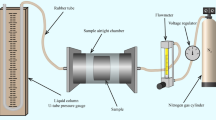Abstract
An electrodeposition method and its experimental device for rehabilitation of cracks in reinforced concrete were proposed. Porous concrete is proposed to simulate cracked concrete, and mass increment, permeation coefficient and sound velocity of ultrasonic wave were used to be evaluating indicators of healing effectiveness of crack rehabilitation in this method. Effect of currency density, concentration of electrolyte solution on healing effectiveness of porous reinforced concretes with different total void ratio was studied. The experimental results indicate that the simulation of porous concrete for cracks can reflect the healing effectiveness of electrodeposition method effectively. Total void ratio of porous concrete has little effect on healing effectiveness of electrodeposition at early ages. The higher the currency density or concentration of electrolyte solution is, the higher the electrodeposition rate and sound velocity in porous concrete are, and the lower the permeation coefficient of porous concrete will be. Mg(OH)2 crystals produced in high current density are large, thin sheet-shaped and arranged loosely.
Similar content being viewed by others
References
Mehta P K. Durability—Critical Issues for the Future[J]. Concrete International, 1997, 19:1–12
ACI. Causes, Evaluation and Repair of Cracks in Concrete Structures[M]. ACI224. 1R-93. 1993:1–14
Sun Mingqing, Li Zhuoqiu, Liu Qingping, et al. A Study on Thermal Self-diagnostic and Self-adaptive Smart Concrete Structures[J]. Cement and Concrete Research, 2000, 30(8):1251–1253
Jacobsen S and Sellevold E J. Self healing of High Strength Concrete after Deterioration by Freeze/Thaw[J]. Cement and Concrete Research, 1996, 26(1):55–62
Ramm W and Biscoping M. Autogenous Healing and Reinforcement Corrosion of Water-penetrated Separation Cracks in Reinforced Concrete[J]. Nuclear Engineering and Design, 1998, 179(2):191–200
Hondel A J and Polder R B. Electrochemical Realkalisation and Chloride Removal of Concrete[J]. Construction Repair, 1992, 6(3):19–24
Otsuki N and Ryu J S. Use of Electrodeposition for the Repair of Concrete with Shrinkage Cracks[J]. Journal of Materials in Civil Engineering (ASCE), 2001, 13(2):136–142
Wolf Hilbertz. Repair of Reinforced Concrete Structures by Mineral Accretion[P]. US, 4440605:1984
Wolf Hilbertz. Mineral Accretion of Large Surface Structure, Building Components and Elements[P]. US, 4246075:1981
Nobuaki Otsuki, Makoto Hisada, Jae-Suk Ryu, et al. Rehabilitation of Concrete Cracks by Electrodeposition[J]. Concrete International, 1999, 21(3):58–63
Jae-Suk Ryu and Nobuaki Otsuki, Crack Closure of Reinforced Concrete by Electrodeposition Technique[J]. Cement and Concrete Research, 2002, 32(1):159–164
Jiang Zhengwu, Sun Zhenping, Wang Yuji, et al. Feasibility Study of Rehabilitation of Cracks in Reinforced Concrete Using Electrodeposition[C]. In: Zhao Tiejun (Eds.). The 6th National Conference Proceedings on High-strength and High-performance Concrete. Beijing: China Building Materials Press, 2004:139–144
Jiang Zhengwu, Sun Zhenping, Wang Peiming. Mechanism of Rehabilitation of Cracks in Reinforced Concrete Using Electrodeposition[J]. Journal of Tongji University (Nature Science), 2004, 32(11):1471–1475
Jiang Zhengwu, Sun Zhenping, Wang Peiming. Experimental Study on Rehabilitation of Cracks in Reinforced Concrete Using Electrodeposition[C]. In: Xing Feng (Eds.). The 6 th National Conference Proceedings on Durability of Concrete Structure. Beijing: China Traffic Press, 2004:473–479
Jiang Zhengwu, Sun Zhenping, Wang Peiming. Effect of Several Factors on Properties of Porous Permeable Concrete[J]. Journal of Building Materials, 2005, 8(5):513–519
Author information
Authors and Affiliations
Corresponding author
Additional information
Funded by the National Natural Science Foundation of China (50508029), Shanghai Provincial Natural Science Foundation (05zr14121) and Open Fund of Shenzhen Key Laboratory of Civil Engineering Durability of Shenzhen University (CED06-01)
Rights and permissions
About this article
Cite this article
Jiang, Z., Xing, F., Sun, Z. et al. Healing effectiveness of cracks rehabilitation in reinforced concrete using electrodeposition method. J. Wuhan Univ. Technol.-Mat. Sci. Edit. 23, 917–922 (2008). https://doi.org/10.1007/s11595-007-6917-x
Received:
Accepted:
Published:
Issue Date:
DOI: https://doi.org/10.1007/s11595-007-6917-x




